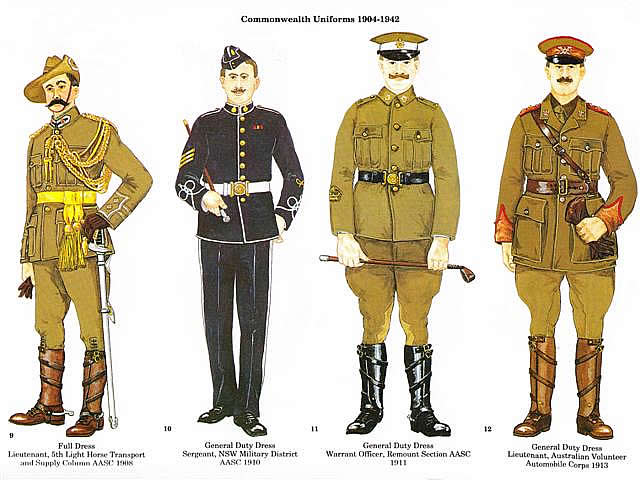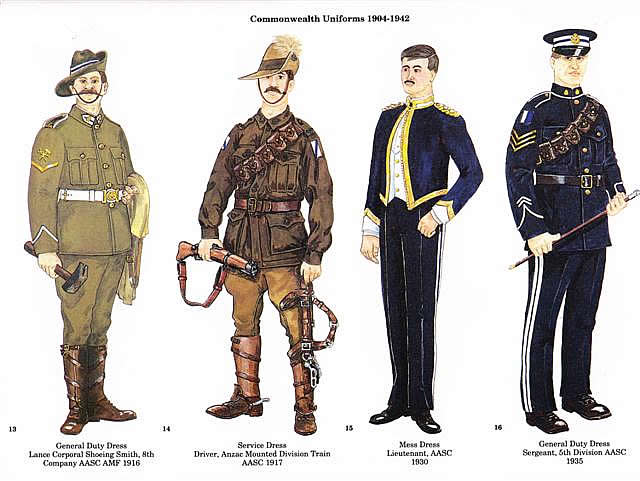AASC Commonwealth Uniforms 1904-1942

9. Full Dress Lieutenant, 5th Light Horse Transport and Supply Column Australian Army Service Corps, 1908
This has been taken from clear photographic evidence which matches the Commonwealth dress regulations. The full dress additions of aiguillettes, sash and sword, could be added to a full dress jacket/tunic with piped, pointed cuffs, or to the serge service jacket with rank on the cuffs, the latter being depicted. For all the intent of economy with one uniform, it is obvious that, with the badge of rank problem and simply maintaining dress uniform condition, it was necessary for officers to maintain a separate dress uniform. The hat has a khaki puggaree with white fold and a badge with white rosette; collar badges are on gorget patches. The initial 1906 badge does not appear to have lasted for long; there are no examples of collar versions, yet as early as the end of that year hat and collar badges similar to the successor version appear on photographs. It is clear that the latter was in use from mid-1907, and that badge has been depicted.
10. General Duty Dress, Sergeant, 1st Infantry Transport and Supply Column Australian Army Service Corps, 1910
The Victorian and NSW Military District elements of the AASC retained blue uniforms, possibly due to the economies of using up existing issues and stocks. The basic uniform changed little, New South Wales winning on their piping being adopted, Victoria on their sleeve knot and double trouser stripe. Head-dress options were a field service cap with white top or the white helmet.
11. General Duty Dress, Warrant Officer, Remount Service Australian Army Service Corps, 1912
The remount sections came to form the bulk of the Permanent AASC. They wore the Commonwealth uniforms and accoutrements but shortly after raising of the remount sections the Permanent leggings and other leatherware were converted to black. The cap band was also, for both Militia and Permanent, changed from a white band to white with a blue stripe, while the puggaree went from khaki with white fold to white hat band with blue centre stripe. The old style cap band is depicted, as old soldiers kept old items as a badge of experience, as borne out by photographic evidence of some years to the future.
12. General Duty Dress, Lieutenant, Australian Volunteer Automobile Corps, 1913
Formed in 1908 this Corps adopted the leather look which was to a small degree carried on by AASC motor transport units in World War I. The original dress regulations provided for red gorget patches discarded within a year, but brown leather facings with red leather welts together with brown leather accoutrements were retained, modified and extended to the extent depicted. The last of the true Volunteers, they joined AASC in 1916, though some minor elements of their dress filtered on to the motor transport units in World War I.

13. General Duty Dress, Lance Corporal Shoeing Smith, 8th Company Australian Army Service Corps Australian Military Forces, 1916
While the AIF at home and overseas adopted the revised service dress and rising sun badges, the conscripted Militia at home continued on in the existing Australian Military Forces uniforms and insignia. The version depicted conforms with the regulations and is demonstrated in extensive photographic evidence, showing gorget patches, shoulder boards, corps titles and unit numbers. Much other evidence shows members stripped progressively of the various items down ultimately to shirt sleeves, with brown leather belts. These utilitarian versions, while realistic enough, have been passed over in the interests of showing the full general dress; the lesser variants appear in photographs in earlier chapters.
14. Field Service Dress, Driver, Anzac Mounted Division Train Australian Army Service Corps Australian Imperial Force, 1917
The service dress is standard, with oxidised rising sun badges and Australia shoulder titles, plus the bandolier and leggings worn by AASC from 1908. Mounted Division Train companies, formed in 1917, wore emu plumes as did all units in the mounted divisions except artillery from 1915. The colour patch is the general AASC one which was adopted in both mounted divisions after the AASC light horse brigade trains, then brigade supply sections, were disbanded.
15. Mess Dress, Captain, Australian Army Service Corps, 1930
This mid-blue mess jacket with gold braid and white facing, trousers with double white stripe, and white waist coat originated in the Victorian Commissariat and Transport Corps as shown in the 1893 Victorian dress regulations, continuing to the Victorian Army Service Corps (1896 regulations) then on through the Australian Army Service Corps to 1942. It disappeared in postwar jackets, a different style and colours being then selected for no obvious logical reason.
16. General Duty Dress, Sergeant, 5th Division Australian Army Service Corps, 1935
Blue uniform and corps embellishments were reintroduced in 1930 after the postwar obsession with things AIF had subsided. A Militia NCO is shown wearing a jacket different from the Permanent full dress tunic in the absence of piping on the jacket and its collar; but the blue stripe on the cap band continued on from 1911. The colour patch is the 5th Division AASC which flowed on from the AIF; the lower sleeve chevrons are good conduct stripes.